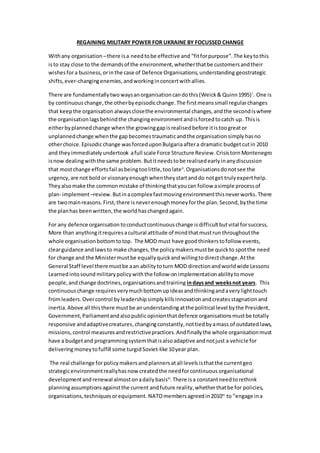
Modern Defence - Think piece
- 1. REGAINING MILITARY POWER FOR UKRAINE BY FOCUSSED CHANGE Withany organisation –there isa needtobe effective and "fitforpurpose”. The keytothis isto stay close to the demandsof the environment,whetherthatbe customersandtheir wishesfora business,orinthe case of Defence Organisations,understanding geostrategic shifts, ever-changingenemies, andworkinginconcertwithallies. There are fundamentallytwowaysanorganisationcandothis(Weick& Quinn1995)i . One is by continuouschange,the otherbyepisodicchange.The firstmeanssmall regularchanges that keepthe organisation alwaysclosethe environmental changes,andthe secondiswhere the organisationlagsbehindthe changingenvironmentandisforcedtocatch up. Thisis eitherbyplannedchange whenthe growinggapisrealised before itistoogreat or unplannedchange whenthe gap becomes traumaticandthe organisation simply hasno otherchoice. Episodicchange wasforceduponBulgaria aftera dramatic budgetcutin 2010 and they immediately undertook afull scale Force Structure Review. Crisistorn Montenegro isnow dealingwith the same problem. Butitneedstobe realisedearlyinanydiscussion that mostchange effortsfail asbeingtoolittle,toolateii .Organisationsdonotsee the urgency,are not boldor visonaryenoughwhentheystartanddo notget trulyexperthelp. Theyalsomake the commonmistake of thinkingthatyoucan follow asimple processof plan- implement–review.Butinacomplex fastmovingenvironmentthisneverworks.There are twomainreasons.First,there isneverenoughmoneyforthe plan.Second,bythe time the planhas beenwritten,the worldhaschangedagain. For any defence organisationtoconductcontinuouschange isdifficultbutvital forsuccess. More than anythingitrequires acultural attitude of mindthatmustrun throughoutthe whole organisationbottomtotop. The MOD must have goodthinkerstofollow events, clearguidance and lawsto make changes,the policymakersmustbe quickto spotthe need for change and the Ministermustbe equallyquickand willingtodirectchange.Atthe General Staff level theremustbe aan abilitytoturn MOD directionandworldwide Lessons Learnedinto soundmilitarypolicywiththe follow-onimplementation abilitytomove people,andchange doctrines,organisationsandtraining indaysand weeksnot years. This continuouschange requiresverymuchbottomupideasandthinkingandaverylighttouch fromleaders. Overcontrol byleadership simply killsinnovation andcreatesstagnationand inertia.Above all thisthere mustbe anunderstanding atthe political level bythe President, Government,Parliamentand alsopublicopinionthatdefence organisationsmustbe totally responsive andadaptivecreatures,changingconstantly,nottiedby amass of outdated laws, missions, control measuresand restrictivepractices.Andfinallythe whole organisationmust have a budgetand programmingsystemthatisalsoadaptive andnotjust a vehicle for deliveringmoneytofulfill some turgidSoviet-like 10year plan. The real challenge forpolicymakersand planners atall levels isthatthe currentgeo strategicenvironmentreallyhasnow createdthe needforcontinuous organisational developmentandrenewal almostonadailybasisiii .There isa constantneedtorethink planningassumptionsagainstthe current andfuture reality,whetherthatbe for policies, organisations,techniquesorequipment. NATOmembersagreedin2010iv to "engage ina
- 2. continuousprocessof reform,modernisationandtransformation"butfew have really graspedthe nettle. Militaryorganisationsnowhave tobe able toadapt constantlyandmustbe organisedin such a way thatthe conceptsof change,flexibility,adaptabilityandinnovationare normal facts of life andpositively encouraged atall levelsof the organisation. Thisisalmostthe total reverse of most FormerWarsaw Pact (FWP) military organisations where control and disciplineare the key drivingconcepts,notthe flexibility demandedby todaysenvironment. Historically militaryorganisations have existedinafairlystable environment,theyhave become mechanisticorganisationsv andhave usually emphasisedstability,conformity and an everincreasingstraight-jacketof rulesandregulationsvi withofficersselectedfortheir abilitytodeliverthisstyle of management.Worse,the financial rulesandexpectationsof the national Treasury themselvesare more towardsstabilityandlongtermplans which themselvesharmthe flexibility any MODneedsto conduct business.Andoftenthe whole systemisgovernedbya national administrative law onstructuresthatactually deliberately stops change.It is ironicthatthe greatestcurrentthreatto EuropeanandNATO security may be itsown lawsandsystems. Addedtothis,and equally ironically,manycountrieshave adoptedthe USA programming system,butwithoutalsoimplementingthe cultural changesinleadership, managementand budgetaryspendingmethodsthatthe systemneedsforsuccess.InmanyFWPcountriesthe tool is beingusedtoallocate moneyforspendingwhichwasneverthe intention. Programmingisdesignedtoidentifyall the future pitfallsof liabilities,highspendingand capabilitydevelopmentrequirements overtime toensure thatthe defence isboth affordable anddeliverable. Thisalsomeansthatto work,programmesmustagregate all the elementsof Capabilityforthe commanderthatrequiresthem, notsplitthemup asnow in Ukraine so noprogramme holdercan have responsibilityforfailure of successof any mission. But the picture isnot all gloom.Inmany areas of worksuch as withinthe ATOUkraine has showan amazingabilitytoadaptand change and deliverthe missionsuccessfully.Butthese compbatactivitieshave beenoverlaidontopof the maindefence structure thatsits below, inert,unchangingandfallingeverfurtherbehindthe environmentalcurve. Successinone part of the systemdoesnotspell successoverall.vii Two areasof seriousconcern are deployability and logisticstructures.Many countrieshave historicallydesignedtheirstructuresforterritorial defence andwithlimitedlogisticcapacity for war.Logisticsare designed oninternal lines andhave limitedcapacity, whereas formost operations andNATOArticle V,those whoare alliance membershave agreedtodeliverviii "maximumdeployabilityof forcesandtheircapacitytosustainoperationsinthe field".At presentmostFWP nationscannotdo thiswithoutseriousUSsupport. Because of the recentand rapidenvironmental changes mostFWP countries now require episodicchange. Thisisnow at sucha seriouslevel andthe requirementssodramaticthatit needstobe considered “transformational”innatureix Thismeanssimplythatthe organisation needstobreakwiththe pastand move ina totally differentdirection.Fine tuningbycontinuouschange isnotnow enough asthe gap betweenthe maindefence
- 3. organisationsandthe environmentalrequirements are toolarge.Change specialistHayes (2002) pointsoutthat thiscritial momentmeansdoingthingsdifferently,notjustbetter, and even doingtotallynewthings. He alsonotesthatthischange becomesmore difficult whenitis leftuntil urgentbecause thereislesstime toengage the full resourcesandenergy of the people concerned.The lackof time reducesthe chancesof innovationand creativity. The challenge forMODs istryingto workthrough a heavyand conservative setof domestic political andbureaucraticviewsthatare anti-change andwantingtokeepthe unaffordable and outdated militarily statusquo. Adaptability andflexibility meanschangingstructures,processesand especially culture butit alsomeansfocussing thinkingandchange upondeveloping the capabilities thatare really needed now –not at some indefinedpointinthe future.Itisnot a planthat isneededbut actiontoday!. These are "the clearlyidentifyable andmeasurablevalue-addingactivitiesthat describe whatthe organisationcando"x . It ismost importantthatthe priority capability requirementsforthe future are those thatget the moneyfirst - not last.Thiscannot happen inmany countries withoutchange of currentstructuresandchangesto longtermplansand programmes. The oldoutdatedstructuresstaythe same and simplyeatmoneythatis neededforthe future organisation.Youcanonlyspendmoneyonce. Lawler&Worley (2006) suggestthatthe greatestcapabilitythe organisationcanhave isthe ”change capability” itself andmost defence organisations simply lackthis. What has happenedsofarinmost FWP defence systems isaweak attemptat incremental change with some limitedprofessionalisationof soldiers,adaptionof the programmingtool, external training, andadoptionof NATO Force or PartnershipGoals.Butthese stepshave beenaddedto the systemwithout fundamental change of the way the system itself works. The base structure and heavycontrol type military culture remainsthe same and bothare increasinglyfallingbehind the geostrategicdemands. The challengeforFWP countries isto graspwithinthe political andmilitaryelite thatthe full implicationsof the demandscreatedbychangesto the total environment,especiallypolitical andfinancial, have not yetstruck home themasserious enoughtotake swiftaction – but the clock is ticking. The neednowthenisfor change,not justa review anda plan.Changingandmodernising thingsmeansalteringthe waythe whole systemdoesbusiness.Thisdoesnothave tomean losingcontrol orcreatinganarchy but itmeansfollowingthe bestlessonsandexperience available fordoingthissortof work. There are manygoodand proven toolsto help MODs leadandmanage change – Lewin(1951)xi withhis 3 stage model, Hayes(2002)xii withan 8 stage model, advocatingusingmodernmanagementtools tohelpdiagnosisof the problems, and Kotter(1998)xiii withhisfamous8 stage processconcentratinguponpeople and deliveringapowerful vision.There are manymore beingusedbymodernconsultants. The keyisto findthe bestbalance of control and supportinginnovationthatwill give the MOD and General Staff the bestframework touse. But whateverframeworktocreate change ischosen,there isstill aneedtogetthe content rightfor modernrequirements andforthe seniorleadershiptobe fullyinvolvedindelivering a betterfuture. Change cannotbe delegatedthenforgotten.Itisa hardtask that needs
- 4. energy,visionandrobustpersistence.But,the alternative isworse.It isnouse simply reducingthe military stucture yearonyearto meetthe budget andhopingthatproblems will goaway.Theywill not. The modernworldnow requiresafundamental rethinkforhow businessisdone todayandthisweek.Evena10 year planis too far awayand highrisk for the nation. i Weick and Quinn 1995,Organizational Changeand Development, University of Michigan ii Jacobs 1994,Real Time Strategic Change iii Hayes 2002,The Theory and Practiceof Change Management - citingthe thoughts of the futurologistToffler iv NATO Strategic Concept– Active Engagement, Modern Defence - 19-20 Nov 2010 v Burns and Stalker 1961 vi Lawler&Worley 2006, Builtto Change – How to achieveSustained Organisational Effectiveness vii Jacobs 1994 Real Time Strategic Change viii NATO Strategic Concept– Active Engagement, Modern Defence - 19-20 Nov 2010 ix Kotter 1999 A Force for Change x Lawler&Worley 2006, Builtto Change – How to achieveSustained Organisational Effectiveness xi Lewin 1951,Field theory in Social Science,New York, Harper and Row xii Hayes 2010,The theory and Practiceof Change Management xiii Kotter 2002, A Force for Change